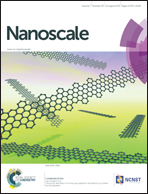Suspended monolayer graphene under true uniaxial deformation†
Abstract
2D crystals, such as graphene, exhibit the higher strength and stiffness of any other known man-made or natural material. So far, this assertion has been primarily based on modelling predictions and on bending experiments in combination with pertinent modelling. True uniaxial loading of suspended graphene is not easy to accomplish; however such an experiment is of paramount importance in order to assess the intrinsic properties of graphene without the influence of an underlying substrate. In this work we report on uniaxial tension of graphene up to moderate strains of ∼0.8%. This has been made possible by sandwiching the graphene flake between two polymethylmethacrylate (PMMA) layers and by suspending its central part by the removal of a section of PMMA with e-beam lithography. True uniaxial deformation is confirmed by the measured large phonon shifts with strain by Raman spectroscopy and the indication of lateral buckling (similar to what is observed for thin macroscopic membranes under tension). Finally, we also report on how the stress is transferred to the suspended specimen through the adhesive grips and determine the value of interfacial shear stress that is required for efficient axial loading in such a system.


 Please wait while we load your content...
Please wait while we load your content...